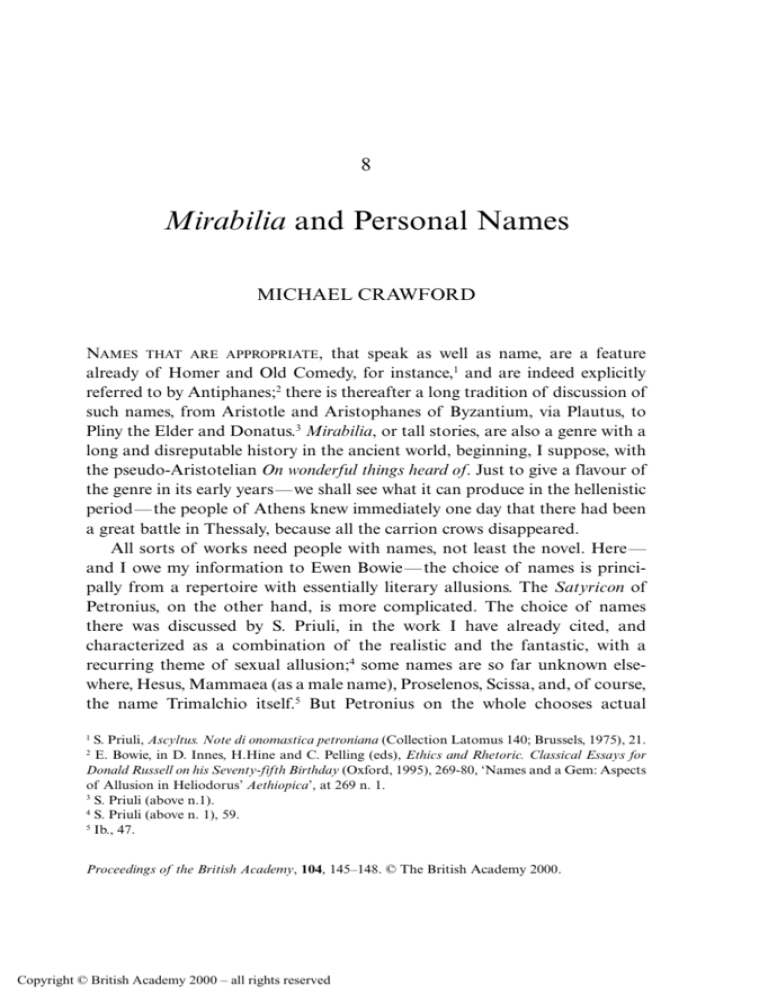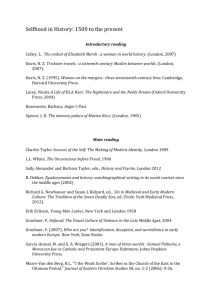
8
Mirabilia and Personal Names
MICHAEL CRAWFORD
NAMES THAT ARE APPROPRIATE, that speak as well as name, are a feature
already of Homer and Old Comedy, for instance,1 and are indeed explicitly
referred to by Antiphanes;2 there is thereafter a long tradition of discussion of
such names, from Aristotle and Aristophanes of Byzantium, via Plautus, to
Pliny the Elder and Donatus.3 Mirabilia, or tall stories, are also a genre with a
long and disreputable history in the ancient world, beginning, I suppose, with
the pseudo-Aristotelian On wonderful things heard of. Just to give a flavour of
the genre in its early years—we shall see what it can produce in the hellenistic
period—the people of Athens knew immediately one day that there had been
a great battle in Thessaly, because all the carrion crows disappeared.
All sorts of works need people with names, not least the novel. Here—
and I owe my information to Ewen Bowie—the choice of names is principally from a repertoire with essentially literary allusions. The Satyricon of
Petronius, on the other hand, is more complicated. The choice of names
there was discussed by S. Priuli, in the work I have already cited, and
characterized as a combination of the realistic and the fantastic, with a
recurring theme of sexual allusion;4 some names are so far unknown elsewhere, Hesus, Mammaea (as a male name), Proselenos, Scissa, and, of course,
the name Trimalchio itself.5 But Petronius on the whole chooses actual
1
S. Priuli, Ascyltus. Note di onomastica petroniana (Collection Latomus 140; Brussels, 1975), 21.
E. Bowie, in D. Innes, H.Hine and C. Pelling (eds), Ethics and Rhetoric. Classical Essays for
Donald Russell on his Seventy-fifth Birthday (Oxford, 1995), 269-80, ‘Names and a Gem: Aspects
of Allusion in Heliodorus’ Aethiopica’, at 269 n. 1.
3
S. Priuli (above n.1).
4
S. Priuli (above n. 1), 59.
5
Ib., 47.
2
Proceedings of the British Academy, 104, 145–148. © The British Academy 2000.
Copyright © British Academy 2000 – all rights reserved
146
Michael Crawford
names if possible, often of great rarity, which have in the context the desired
overtones. The name Ascyltus turned up in an inscription only in 1966, and
in the context of the Satyricon has the sense of ‘inexhaustible’, in the obvious context.
But Mirabilia, at any rate those with which I am here concerned, are different in their approach, and indeed different among themselves also. The
texts at issue are three stories preserved by Phlegon of Tralles, an edition of
one of which, prepared by a group of graduate students at University
College London, is due to go to press this summer. What I have to say owes
a particular debt to Rebecca Flemming and Jason Davies. Although all the
stories are first attested for us in the second century AD, I am reasonably certain that all are second century BC or thereabouts in origin.
The first story, incomplete at the beginning, is a relatively straightforward
account of a young woman, Philinnion of Amphipolis, who dies and returns
to make love with a visitor at her parents’ house; when she ‘dies’ once more,
however, it is deemed necessary to bury her outside the territory of the city and
to perform various purificatory rites. This first story formed the basis of
Goethe’s Die Braut von Korinth.6 The second story is that of an ‘Aitolarch’
called Polykritos, who dies on the fourth night of his marriage to a Lokrian
woman. She in due course bears a hermaphrodite child.7 While the Aitolians
are deliberating what to do, Polykritos appears and asks for the child, promising that this will avert unspecified disasters for the Aitolians. When they hesitate, he eats the child, except for the head, and disappears. The head prophesies
disasters for the Lokrians and the Aitolians. The following year war between
the Aitolians and the Akarnanians causes much loss of life on both sides. The
third text begins with an officer of Antiochos III rising from the dead after
the Roman victory at Thermopylae in 191 BC and delivering a warning to the
Romans; a prophecy of Delphi against Rome is followed by a series of prophecies of destruction for Rome delivered by the Roman general ‘Publius’.
The first story, of Philinnion of Amphipolis, involves also four other
named participants, her mother and father, Charito and Demostratos, her
lover, Machates, and a local figure who offers advice, Hyllos. The name
Philinnion itself—and everything that I have to say about the distribution of
6
See L. Collison Morley, Greek and Roman Ghost Stories (Oxford, 1912), 66–71. There is a new
translation of this, as well as of the following two stories, in W. Hansen, Phlegon of Tralles’
Book of Marvels (Exeter, 1996).
7
There is a survey of the theme by L. Brisson, in Hommages à M. Vermaseren, I (Leiden, 1978),
80–122, ‘Aspects politiques de la bisexualité’.
Copyright © British Academy 2000 – all rights reserved
MIRABILIA AND PERSONAL NAMES
147
names comes of course from Peter Fraser, Elaine Matthews and the LGPN
database—is apparently unique, though Philinna is very common, as is the
-ion termination in female names. Charito is rare, occurring BC only in
Athens and Hermione in the Argolid, with two and one attestations respectively. The name Hyllos is again principally Athenian, the name Demostratos
panhellenic. Only the name of the lover, Machates, has a northern Greek
distribution, with a particularly heavy concentration in Epirus and
Macedonia. I suspect that we have an essentially Athenian literary creation,
set in Amphipolis, in which there was a long-standing Athenian interest, with
the use of one common northern Greek name.
The third story has been much studied: the remarkable series of prophecies of destruction for Rome has ensured that. The account is centred on the
Roman general called Publius, serving against Antiochos III of Syria after
the battle at Thermopylae in 191 BC. After a Roman victory, a corpse named
Bouplagos arose from the battlefield predicting, in hexameters, future disaster for the Romans: in response the Romans sent to Delphi where the Pythia
warned them to draw back. With little narrative to connect the scenes,
Publius began giving prophecies in hexameters and prose, including one that
a red wolf was about to attack and eat him, and that the soldiers were not to
interfere. This duly happens; he is ripped up and while his head remains lying
on the ground, it gives a prophecy of Roman military disaster on Athena’s
design, at one point claiming to be the voice of Delphic Apollo, whose agent,
the wolf, has brought him to the domains of Persephone. After being ordered
to desist from touching the head when they had approached to bury the
remains (perhaps limbs), the Romans established a shrine and altar to Apollo
Lykios and left. There is the postscript that all the predictions came true.
Until my colleagues got to work on the text, no one, so far as I know, had
paid any attention to Bouplagos. Let me repeat the beginning of the narrative:
‘Now a certain Bouplagos, a Syrian cavalry commander. who stood high in the
estimation of Antiochos, had fallen, after himself also fighting bravely. While
the Romans were collecting together all the spoils—it was the middle of the
day—Bouplagos stood up from among the dead, with his twelve wounds, and
approaching the camp of the Romans spoke these lines in a faint voice:
“Cease despoiling the army which has gone down to the land of Hades; already
Zeus the son of Kronos is angry at the sight of deeds of evil and at the slaughter of the army and your works; he will send a brave-hearted company against
your land, who will deprive you of empire and will pay you back for what you
have done.”’
Copyright © British Academy 2000 – all rights reserved
148
Michael Crawford
Nor would it have been possible to get very far here either without the LGPN
database. But what it shows, even allowing for the fact that it is of course not
complete, is very remarkable. The name Βοπλαγο is of extreme rarity.
There are just three attestations from the single tiny Thessalian city of
Pythion, all c. 400–300 BC (SEG 35, 662; Arch. Eph. 1924, 149, no. 392.4; IG
IV (1)2, 94, Ib, 39) and one of a Macedonian from Phthiotic Thebes (IG IX
(2) 174); the father of this last is Menneias, a name with eight out of twelve
attestations in Thessaly. The name is much more likely to have occurred in a
historical narrative than to have been pulled out of the air.
Now this third story belongs to the category of history as prophecy. A
prophet in the 180s BC locates himself in the past and ‘prophesies’ the events
which have just occurred, gaining credence thereby for the element of ‘real’
prophecy at the end. Because the prophecies in our story relate to the history of Rome, we are reasonably well informed and we can locate them with a
fair amount of confidence. In particular, we can see that the Roman general
both ‘is’ and ‘is not’ Scipio Africanus, who died in his bed at Liternum, rather
than being eaten by a red wolf.
It is at this point that the second story, about the ‘Aitolarch’ Polykritos,
comes in. The name Polykritos occurs everywhere in the Greek world, but
not very much in central Greece, and only once in Aitolia, the general and
plunderer of temples of Polybius 9. 34. 9–10, who is perhaps also epigraphically attested (IG IX (1)2 (1) p. xlix). I suspect that the central figure of the
second story in Phlegon of Tralles, on the analogy of the central figure of the
third story, both ‘is’ and ‘is not’ this Polykritos, and that if we knew more
about the history of Aitolia in the third century BC we should be able to
locate the story in the same way as we can locate the third story. There is one
pointer: the outcome of the second story, although the omen was
unfavourable to the Aitolians and the Lokrians, was a disastrous war
between the Aitolians and the Akarnanians. And the Aitolian temple plunderer Polykritos is a figure in history because his name is inserted into a
speech put into the mouth of Lykiskos the Akarnanian.
Copyright © British Academy 2000 – all rights reserved
Abbreviations
J. and L. Robert and others, Bulletin Épigraphique (in Revue des Études
grecques, 1938– )
Bechtel, HP F. Bechtel, Die historischen Personennamen des Griechischen bis zur
Kaiserzeit (Halle, 1917)
CEG
P.A. Hansen, Carmina Epigraphica Graeca, vol. 1, saeculorum VIII–V a.
Chr. n.; vol. 2, saeculi IV a. Chr. n. (Berlin, 1983, 1989)
FD
Fouilles de Delphes 1– (Paris, 1909– )
Hatzopoulos, Macedonian Institutions M.B. Hatzopoulos, Macedonian Institutions
under the Kings, 2 vols (Meletemata 22; Athens, 1996)
Hatzopoulos-Loukopoulou, Recherches M.B. Hatzopoulos and L. Loukopoulou,
Recherches sur les marches orientales des Téménides, i (Meletemata 11;
Athens, 1992)
Letronne, Oeuvres choisies Oeuvres choisies de J.-A. Letronne, assemblées, mises en
ordre et augmentées d’un index par E. Fagnan (Paris, 1881–5: 1 sér.
Égypte ancienne, 2 vols, 1881; 2 sér. Géographie et cosmographie, 2 vols,
1883; 3 sér. Archéologie et philologie, 2 vols, 1883–5)
LGPN
A Lexicon of Greek Personal Names I, The Aegean Islands, Cyprus and
Cyrenaica, eds P.M. Fraser and E. Matthews (Oxford, 1987); II,
Attica, eds M.G. Osborne and S.G. Byrne (Oxford, 1994); IIIA, The
Peloponnese, Western Greece, Sicily and Magna Graecia, eds P.M.
Fraser and E. Matthews (Oxford, 1997); IIIB, Central Greece, eds
P.M. Fraser and E. Matthews (forthcoming, 2000)
LIMC
Lexicon iconographicum mythologiae classicae (Zurich and Munich,
1981–97)
LSAG2
L.H. Jeffery, The Local Scripts of Archaic Greece, 2nd edn, with supplement by A.W. Johnston (Oxford, 1990)
ML
R. Meiggs and D. Lewis, A Selection of Greek Historical Inscriptions
to the End of the Fifth Century BC, revised edn (Oxford, 1988)
OCD3
S. Hornblower and A. Spawforth (eds), Oxford Classical Dictionary,
3rd edn (Oxford, 1996)
OGS
O. Masson, Onomastica Graeca Selecta, ed. C. Dobias and L. Dubois,
2 vols (Paris, 1990)
Osborne, Naturalization 3–4 M. J. Osborne, Naturalization in Athens, 3-4 (Brussels,
1983)
BE
Copyright © British Academy 2000 – all rights reserved
viii
Abbreviations
PA
J. Kirchner, Prosopographia Attica, 2 vols (Berlin, 1901)
Pape-Benseler W. Pape and G.E. Benseler, Wörterbuch der griechischen Eigennamen
(Braunschweig, 1863–70)
Parker, Athenian Religion R. Parker, Athenian Religion: A History (Oxford, 1996)
Robert, OMS L. Robert, Opera Minora Selecta: Épigraphie et antiquités grecques, 7
vols (Amsterdam, 1969–90)
SEG
Supplementum Epigraphicum Graecum, eds J.E.E. Hondius and A.G.
Woodhead, 1–25 (Leiden, 1923–71); eds H.W. Pleket and R.S. Stroud,
26–7 (Alphen, 1979–80), 28– (Amsterdam, 1982– )
SGDI
H. Collitz, F. Bechtel and others, Sammlung der griechischen DialektInschriften, 4 vols (Göttingen, 1884–1915)
Sittig
E. Sittig, De Graecorum nominibus theophoris (diss. Halle, 1911)
Copyright © British Academy 2000 – all rights reserved






